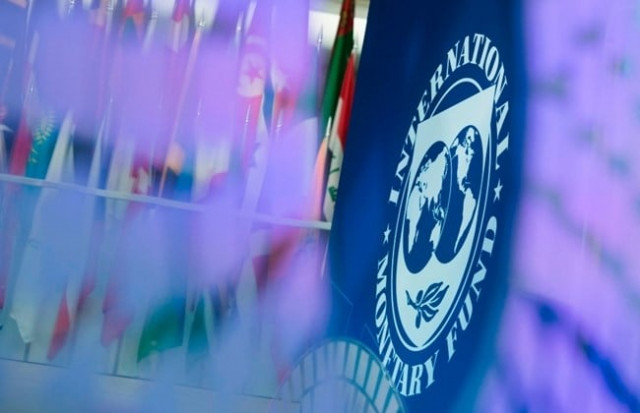‘IMF plan to dampen economy’
World Bank report reveals unemployment, poverty have increased due to pandemic

Economic activity in Pakistan will remain dampened in the short term due to the revival of International Monetary Fund (IMF) loan programme while unemployment and poverty have already gone up - with over 30% of rural population slipping into poverty, reveals a new World Bank report.
The World Bank’s views about adverse impacts of the IMF programme are also shared by some Pakistani cabinet ministers, who in private told The Express Tribune that the IMF programme could not go till the end unless the harsh, already accepted conditions for electricity prices and taxes were softened.
In its Pakistan Development Update - Navigating in Uncertain Times, the World Bank said on Tuesday that the percentage of foodinsecure population had tripled from 3% to 10% due to the adverse impact of Covid-19 on daily lives.
The World Bank has again projected just 1.3% economic growth for the current fiscal year, which is slightly lower than the IMF forecast given in the World Economic Outlook, also released on Tuesday.
The IMF - World Bank’s sister Bretton Woods institution - projected only 1.5% economic growth for Pakistan in the current fiscal year and 4% in the next fiscal year.
The IMF also projected average 10% inflation rate in Pakistan this year, which it stated may slow down to 7.9% in the next fiscal year.
However, the World Bank’s detailed report on Pakistan should set off alarm bells in the power corridors, as the report does not carry any good news on the social and economic landscape of Pakistan.
The World Bank said that economic growth in Pakistan was expected to recover slowly, given heightened uncertainty surrounding the Covid-19 pandemic, including the emergence of new strains and the availability of mass vaccinations.
“At the same time, economic activity is projected to be dampened in the short term by fiscal consolidation measures associated with the resumption of the IMF stabilisation programme, expected to resume as the economy regains its footing,” read the report.
It said that the outlook entailed a gradual post-Covid recovery, during which economic growth was expected to remain below potential, reaching 1.3% in the current fiscal year and strengthening to 3.4% in fiscal year 2022-23 - the last year of the Pakistan Tehreek-e-Insaf (PTI) government.
The World Bank stated that while domestic economic activity was expected to recover with the easing of lockdown measures and social restrictions along with the gradual administration of vaccines, Pakistan’s near-term economic prospects were subdued.
Cabinet sources told The Express Tribune that the next few months were tumultuous for Pakistan’s economy.
They said that if the government implemented the IMF programme, it would increase inflation and poverty and if the government did not, it would send wrong signals to the world.
Prime Minister Imran Khan has removed Abdul Hafeez Shaikh from the post of finance minister for agreeing to some of the IMF conditions without fully disclosing their adverse impact, including the SBP Amendment Bill, said the sources.
“Pakistan’s economy will this year grow at a faster rate than earlier forecasts. Starting from next fiscal year, we will be targeting an even higher growth rate that may exceed 4% per annum,” said Finance Minister Hammad Azhar.
The World Bank said that there were also considerable downside risks to Pakistan’s economic outlook, especially with the ongoing third wave of the infection that could trigger more protracted and extensive lockdowns, stifling the fragile recovery.
“Delayed deployment of the Covid19 vaccines, both domestically and globally, would further elevate these risks,” it added.
Poverty, unemployment
While citing a government’s survey, the World Bank said that half of Pakistan’s workforce was severely hit by the Covid-19 crisis. It is estimated that 20.7 million workers (37% of the total) lost their jobs and an additional 6.7 million workers (12%) saw a decline in their labour income between April and July 2020.
The Washington-based lender added that simulation results indicated that poverty in the last fiscal year, as measured through the official national poverty line, might have increased by 2.3 percentage points, which translated into 5.8 million additional people falling into poverty as a result of the pandemic.
The report showed that poverty in rural areas increased from pre-Covid-19 level of 28.1% to 30.6%.
Similarly, in urban areas, the poverty level surged from 10.8% to 12.9%, according to the World Bank.
The Covid-19 pandemic is expected to not only increase poverty, but also worsen the depth and severity of poverty among the already poor, as indirectly demonstrated by the increase in the share of severely food-insecure population, which stood at 10% during the lockdown phase, compared to 3% at the baseline. The long-run poverty impact of the Covid-19 crisis remains unclear.
Recent estimates indicate that Pakistan’s labour market has almost fully returned to its pre-lockdown levels.
Nevertheless, the severity of the crisis amongst the poorest and most vulnerable segments of the population might have long-lasting consequences, said the World Bank.
Inflation
The report has shown the headline consumer price inflation at 9% in this fiscal year, “as the recent hike in energy prices is likely to maintain an upward pressure on prices for the remainder of the year”.
Inflation is expected to decline over the forecast horizon given the persistence of spare capacity in the economy, and as food price inflation continues to moderate with the gradual resolutions of supply chains disruptions. The inflationary pressures from energy price hikes in the last fiscal year continue to dissipate, said the lender.
In a footnote, it noted that electricity and gas tariffs steadily increased from July 2019 to January 2020 as a 168% hike in gas tariffs was approved at the beginning of FY20 to pass on energy sector arrears to consumers.
These tariff hikes were a key contributory factor to the high headline inflation in FY20, it added












1726134115-0/BeFunk_-(41)1726134115-0-208x130.webp)






COMMENTS
Comments are moderated and generally will be posted if they are on-topic and not abusive.
For more information, please see our Comments FAQ